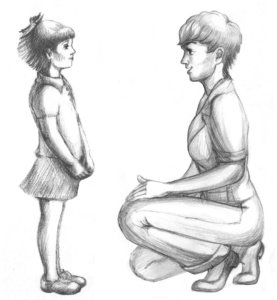by Lee Havis
 In the technology of scientific education, “eye contact” like other techniques, only works as intended when applied within the bounds and regulatory control of specific protocols, such as well-being of the total environment, and least amount of adult involvement.
In the technology of scientific education, “eye contact” like other techniques, only works as intended when applied within the bounds and regulatory control of specific protocols, such as well-being of the total environment, and least amount of adult involvement.
So, the danger of eye contact occurs when it is not used inthis manner for neutral, non-judgmental interaction with the child. This happens, for example, when you add some manipulative frown, smile, or head gesture to eye contact alone, which then projects some judgment or feeling of approval or displeasure.
 There is also danger in eye contact when you linger too long in your “eye contact” gaze with a child due to an unconscious need for comfort or undue personal intimacy with the child. In time, this prolonged, unnecessary eye contact creates a mutual dependency in the adult-child relationship, which can lead to a power struggle and disorder when the child later disobeys or disregards your clear direction in some way.
There is also danger in eye contact when you linger too long in your “eye contact” gaze with a child due to an unconscious need for comfort or undue personal intimacy with the child. In time, this prolonged, unnecessary eye contact creates a mutual dependency in the adult-child relationship, which can lead to a power struggle and disorder when the child later disobeys or disregards your clear direction in some way.
 If you find yourself drawn into this type of dependency “eye contact” drama with a child, the solution is to decisively disengage from any eye contact with that child for a while, until you can restore a more normal, natural relationship. And in the future, be sure to keep your eye contact brief, non-judgmental and on purpose for effective scientific teaching with all children in your group.
If you find yourself drawn into this type of dependency “eye contact” drama with a child, the solution is to decisively disengage from any eye contact with that child for a while, until you can restore a more normal, natural relationship. And in the future, be sure to keep your eye contact brief, non-judgmental and on purpose for effective scientific teaching with all children in your group.

